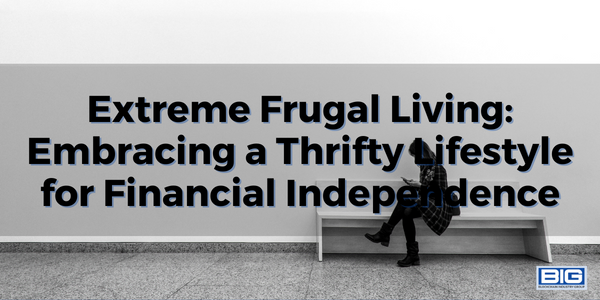
In a world of consumerism and materialism, the concept of extreme frugal living has gained traction as a way to achieve financial independence and freedom.
This article explores the principles and strategies behind extreme frugal living, showcasing how individuals can embrace a thrifty lifestyle to take control of their finances and work towards achieving their long-term goals.
Understanding Extreme Frugal Living
Extreme frugal living goes beyond traditional budgeting and expense tracking. It involves a deliberate and conscious effort to minimize expenses, save aggressively, and prioritize financial goals over instant gratification. By adopting extreme frugality, individuals can maximize their savings, reduce debt, and build a solid foundation for long-term financial independence.
Embracing Minimalism: Less is More
One of the core principles of extreme frugal living is embracing minimalism. Minimalism encourages individuals to simplify their lives, declutter their possessions, and focus on experiences rather than material possessions. By reducing the desire for unnecessary consumption, individuals can save money, reduce environmental impact, and find greater satisfaction in life’s simple pleasures.
Example: Tiny House Movement
The tiny house movement is a prime example of embracing minimalism in extreme frugal living. Individuals choose to live in small, efficient homes that are designed to meet their basic needs. By downsizing their living spaces, they not only save money on mortgage or rent but also minimize maintenance costs and utility bills.
Cutting Expenses to the Bone: Creative Cost-Cutting Strategies
Extreme frugal living requires a creative approach to cutting expenses. It involves finding innovative ways to reduce costs without compromising on essential needs. From slashing grocery bills through couponing and meal planning to finding affordable alternatives for transportation and entertainment, extreme frugalists prioritize frugality in every aspect of their lives.
Example: Dumpster Diving
Dumpster diving is an unconventional yet effective strategy embraced by extreme frugalists. They scour dumpsters behind grocery stores or restaurants to find perfectly edible food that has been discarded due to expiration dates or minor damages to packaging. By salvaging these items, individuals can significantly reduce their grocery expenses.
Maximizing Savings and Investments: The Power of Compound Interest
Extreme frugal living emphasizes the importance of maximizing savings and investments. By diligently saving a significant portion of their income and investing it wisely, individuals can take advantage of the power of compound interest to grow their wealth over time. They prioritize long-term financial goals, such as retirement or financial independence, over short-term gratification.
Example: FIRE Movement
The FIRE (Financial Independence, Retire Early) movement is closely aligned with extreme frugal living. Followers of FIRE aim to save and invest a large portion of their income, sometimes up to 50% or more, to achieve financial independence at an early age. By diligently saving and investing, they can accumulate enough wealth to retire and pursue their passions without relying on traditional employment.
The Psychology of Extreme Frugality: Mindset and Values
Extreme frugal living is not merely about cutting costs; it is a mindset shift and a reflection of personal values. It requires individuals to examine their relationship with money, challenge societal norms, and redefine their priorities. By embracing frugality as a lifestyle, individuals can develop discipline, gratitude, and a deeper appreciation for the true value of money.
Example: The Buy Nothing Year
Eating Well Without Breaking the Bank
—
Financial Alchemy: Unveiling the Esoteric Principles of Wealth Creation
—
Financial Planning for the Retirement Years
The Buy Nothing Year is an extreme frugality challenge where individuals commit to not buying anything new for an entire year. They focus on using what they already have, borrowing, swapping, or finding second-hand alternatives. This exercise not only saves money but also brings awareness to consumption habits and cultivates a sense of resourcefulness.
Extreme frugal living offers a path to financial independence and freedom by challenging consumerist norms and embracing a conscious and intentional approach to spending and saving. By adopting the principles of extreme frugal living, individuals can regain control over their finances, reduce debt, and build a solid foundation for a more secure future. While extreme frugality may require sacrifices and lifestyle adjustments, the long-term benefits are significant. Not only does it provide financial independence, but it also encourages a more sustainable and mindful way of living. By embracing a thrifty lifestyle, individuals can break free from the shackles of consumerism, prioritize their values, and find fulfillment in simplicity. So, whether you choose to embark on an extreme frugal living journey or incorporate elements of frugality into your life, remember that every small step counts and brings you closer to financial independence and a more fulfilling life.



